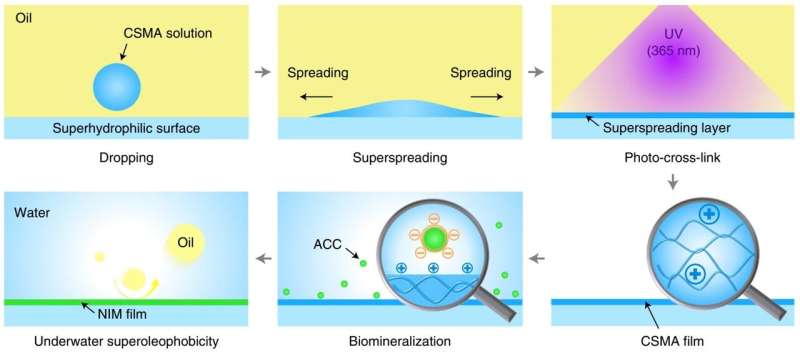Fabrication procedure of the nacre-inspired mineralized film based on superspreading and biomimetic mineralization. Credit: Meng et al
Special wettability of solid surfaces is a ubiquitous phenomenon in nature and has attracted much attention because of its potential applications in diverse fields, such as oil-water separation, antibiofouling and drag reduction. Inspired by some biological organisms observed in nature with underwater superoleophobic properties, such as fish scales, columnar nacre and seaweed, researchers are trying to design and create novel interfacial materials.
Various inorganic and organic materials have been used to fabricate underwater superoleophobic surfaces similar to those found in nature till now. However, most inorganic materials have limited transparency and robustness. It is because of the extensive light scattering effect from surface micro/nano structures, and organic materials do not have sufficient mechanical strength.
In a study recently published in Nature Protocols, Prof. Meng Jingxin from the Technical Institute of Physics and Chemistry of the Chinese Academy of Sciences (TIPC, CAS) and Prof. Wang Bailiang from Wenzhou Medical University reported a protocol for preparing a transparent and robust superoleophobic film that can be used underwater.
"Natural nacre exhibits exceptional mechanical performance in protecting the internal soft body. It is greatly depending on the biomineralization-induced hierarchical organization of approximately 5% organic matrix and 95% inorganic aragonite component. Interestingly, when exfoliating a thin film from natural nacre (e.g., Anodonta woodiana), the film is not only highly transparent underwater but also mechanically robust," said Prof. Meng.
Before this, Prof. Meng and Prof. Wang have already reported a biomimetic mineralized film with robust underwater superoleophobicity inspired by nacre, which was selected as the head page of the journal and was granted the Chinese patent authorization.
In addition, underwater superhydrophobic coatings were prepared on metal surfaces and mesh surfaces for efficient oil-water separation.
In this work, the film was formed by a hydrogel layer prepared by the super-spreading of chitosan solution on a superhydrophilic substrate and biomimetic mineralization of this layer.
In contrast to conventional hydrogel-based materials, the film exhibits significantly improved mechanical properties due to the combination of high-energy, ordered, inorganic aragonite and homogeneous external hierarchical micro/nano structures, leading to robust underwater superoleophobicity and ultralow oil adhesion.
Importantly, the ingenious integration of transparency and mechanical robustness into underwater superoleophobic materials significantly expands their potential applications in emerging fields, such as underwater optics and microfluidic devices.
More information: Wei Chen et al, Nacre-inspired underwater superoleophobic films with high transparency and mechanical robustness, Nature Protocols (2022). DOI: 10.1038/s41596-022-00725-3
Journal information: Nature Protocols
Provided by Chinese Academy of Sciences
























